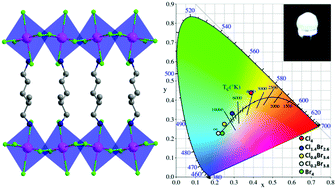Realization of “warm” white light via halide substitution in polar two-dimensional hybrid perovskites (2meptH2)PbClxBr4−x†
Abstract
Broadband white-light emissive two-dimensional (2D) metal halide perovskites have attracted increasing attention in solid-state optical applications. Herein, we present a family of polar 2D hybrid perovskites, (2meptH2)PbClxBr4−x (2mept = 2-methyl-1,5-diaminopentane, x = 0–4), which emit intrinsic broadband emissions with tunable photoluminescence from “cold” white light to “warm” white light. Importantly, a high-performance “warm” white light with a correlated colour temperature of 3958 K and an excellent colour rendering index of 84 was successfully realized in (2meptH2)PbCl4, making it ideal for indoor lighting applications. Mechanistic studies disclose that the broadband white-light emissions are attributed to self-trapped excitons stemming from the strong electron–phonon coupling in the distorted structure, which reasonably explained the emission changes in the mixed-halide perovskites. Such halide substitution inducing high tunability in white-light emissions provides a deep understanding on the underlying structure–property relationship, and further conducts the design of desirable white-light emissive materials.



 Please wait while we load your content...
Please wait while we load your content...